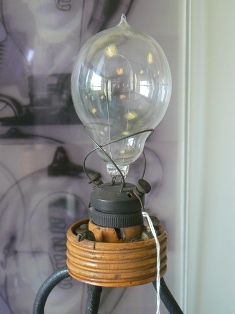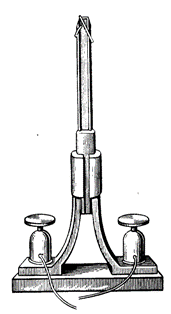The beginning of the development of electric lighting
The idea of using electric energy for lighting appeared even in the first researchers of galvanic electricity. In 1801 L.Zh. Tenar, passing an electric current through platinum wire, brought it to white heat. In 1802 the Russian physicist VV Petrov, having received for the first time an electric arc, noticed that it could be illuminated by "dark rest". Then he observed an electric discharge in a vacuum accompanied by a glow.
A few years later, the English scientist G. Davy also expressed the idea of the possibility of lighting with an electric arc. Thus, in the experimental works of the early nineteenth century, Three fundamentally different possibilities of electric illumination, realized later in incandescent lamps, arc and gas-discharge lighting devices, were already revealed, however, before their practical development, it was far away.
The first attempts were directed to the creation of a light source, which acts as a result of the filament of the conductor. In 1820, the French scientist Delarue proposed a cylindrical tube with two end clamps for supplying current and a platinum helix as a glow body. The lamp was not suitable for practical use. Inventive thought turned to finding acceptable materials for the body of incandescence and the technology for obtaining it.

The Belgian engineer Jobar in 1838, the Russian inventor Barshchevsky in 1845, the German mechanic G. Gebel in 1846, the English physicist DV Swan in 1860 proposed new designs and improvements, but no tangible success was achieved. At the same time, it was found that platinum, charred vegetable fibers or retort coal could be used as the heating body. True, platinum was too expensive, and coal - short-lived. To increase the service life of laboratory samples, G. Gebel in 1856 placed the glow body in a vacuum.
By 1860, the creation of the Russian lieutenant colonel VG Sergeev an original spotlight (lamp-headlight), designed to illuminate the mines. The glowing body in the lamp was a platinum helix; Water cooling of the device was provided.
Noticeable progress in the creation of electric lighting devices came in the 70 years thanks to the work of the Russian inventor A. N. Lodygin and American inventor TA Edison. During the years 1873-1874. Lodygin repeatedly arranged temporary electric lighting in the streets and public buildings of St. Petersburg with the help of luminaries created by him.
As the filament body, they used rods from retort coal; To increase the longevity in a number of samples (Lodygin-Didrikhsons), several pins were mounted, which were automatically turned on instead of burnt, and air was pumped from the cylinders. Lodygin first demonstrated the practical suitability and operational convenience of incandescent lamps, breaking the barrier of skeptical attitude of many scientists and engineers to the principle possibility of implementing this type of lighting.

The design of the incandescent lamp: a - Lodygin-Didrichson, b - Edison
In 1879 Edison, having obtained high-quality materials for the body of incandescence and improved air evacuation from the balloon, created a lamp with a long service life, suitable for mass consumption. Especially rapid development of electric lighting begins after mastering the technology of manufacturing tungsten filaments. The method of using tungsten (or molybdenum) for the filament body was first given by AN Lodygin who proposed in 1893 to incandescent platinum or carbon filament in an atmosphere of tungsten (or molybdenum) chloride compounds together with hydrogen. Since 1903 Austrians Just, F. Hanaman began to use the idea of Lodygin in the industrial production of incandescent lamps.
The introduction of electric lighting promoted the development of various branches of electrical engineering (electrical machine building, electrical insulation equipment, instrumentation) and ultimately created objective conditions for the transition to centralized electricity supply.
At a certain stage, an important historical role in the development of electrical engineering also belonged to arc illumination. Interest in the development of arc sources of light appeared somewhat later than to incandescent lamps, since it seemed difficult to create an arc lamp design in which the distance between the electrodes would remain unchanged as they burned. In addition, for a long time it was not possible to develop a technology for manufacturing high-quality carbon electrodes.
The first arc lamps with manual adjustment of arc length were built by the French - the scientist JBLL Foucault and the electrical engineer A.J. Arshro in 1848. These lamps were only suitable for short-term illumination. Inventive thought is directed to the creation of automatic regulators with clock mechanisms and with electromagnetic devices. In the 50-70s, these were the most common electroautomatic devices. Arc lamps with regulators have received some application on lighthouses, for lighting harbors and large rooms that require intensive illumination.
However, the designs of electric arc lamps with regulators, for the improvement of which they spent a lot of effort, could not serve for mass application. A radical solution to the problem was found by Russian inventor PN Yablochkov, who proposed in 1876 an arc lamp without a regulator - an "electric candle".
Yablochkov's decision was ingeniously simple: arrange the electrode coals, isolating them with a thin layer of kaolin, parallel to each other and put vertically. In this position, as the coals burned, the distance between them did not change-they burned like a candle, and the need for a regulator fell away. In the process of improving his invention, Yablochkov came to the most interesting decisions, which had a significant impact on the entire course of the development of electrical engineering.
First of all, this concerned the development of alternating currents in practice. Throughout the preceding period, the use of electricity was based exclusively on direct current. There was a belief that alternating current is not suitable for technical purposes. To supply the same candles, as noted by Yablochkov, the alternating current was better suited, which ensured the uniform combustion of both coals. In a short time, the lighting installations in the Yablochkov system were switched to alternating current power. The natural result was the increased demand for generators of single-phase alternating current.

Electric candle PV Yablochkov
Yablochkov belongs to the merit of solving the problem of lighting by any number of lamps from a single generator. Prior to it, each arc lamp had to have its own current source. Yablochkov developed several very effective schemes of "electric energy fragmentation", one of which - crushing by induction coils - formed the basis for the construction of AC power plants, and the induction coils themselves became a significant milestone in the development of a transformer. In Yablochkov's schemes, for the first time, the main elements of modern power plants appeared: a primary engine, a generator, a transmission line, and receivers.
Electric candles Yablochkov, called "Russian light", in the late 70's appeared on the streets and public buildings of many capitals of the world; They penetrated into the production buildings of large plants, construction sites, shipyards, etc. Since the fall of 1878, after the establishment of the PN Yablochkov enterprise in St. Petersburg to manufacture electric machines and apparatus, the introduction of electric lighting in Russia has also visibly accelerated.
The growth of arc electric lighting installations caused the need for powerful current sources. The emergence of a dynamo - an economical electric machine generator - contributed to the expansion of the sphere of energy use of electricity. The development of a relatively cheap and affordable receiver of electrical energy has led to the birth of the idea of a centralized electricity production. Thus, electric arc lighting, without entering further. In practice as widely as incandescent lighting, played a great historical role in the development of new areas of electrical engineering.
Shukhardin S. "Technology in its historical development"


You can also support shram.kiev.ua, press:
It will not be superfluous for your friends to learn this information, share their article with them!

Comments
Commenting on, remember that the content and tone of your message can hurt the feelings of real people, show respect and tolerance to your interlocutors even if you do not share their opinion, your behavior in the conditions of freedom of expression and anonymity provided by the Internet, changes Not only virtual, but also the real world. All comments are hidden from the index, spam is controlled.